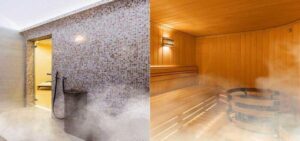The main characteristics that set infrared spas and steam rooms apart are their construction and heating systems. Although steam rooms have sealed rooms that heat the body indirectly through wet heat, infrared baths are usually wooden shelters that use infrared rays to heat the body directly. Detoxification and relaxation are two possible advantages of each. For more knowledge of the basic differences, similarities, and benefits of infrared and steam sauna combos, read on.
Table of Contents
Key elements of an infrared sauna
Infrared saunas use certain light wavelengths to create heat, imitating the effects of sunshine on the body to raise body temperature and cause large amounts of sweating. Their popularity exceeds that of spas because they are less expensive and can be installed in homes, making them more readily available to a larger number of people. As a modern method of space heating, infrared baths are widely valued for their flexibility to meet enjoyable as well as medical needs, making them ideal additions to homes.
Possible advantages of infrared sauna
There are several possible advantages to infrared saunas that might improve general health and wellness. They are widely recognized for their ability to calm anxiety, increase blood flow, and encourage relaxation. The following are some possible benefits of utilizing an infrared sauna:
- Detoxifying.
- Improved quantity of sleep.
- Relaxing muscles.
- Skin renewal.
- Control of weight.
According to research, using an infrared sauna may improve sleep quality by increasing body temperature and promoting sweating. Certain wavelengths serve to improve this process, which increases blood flow and reduces muscular tightness. The body relaxes as a result of less muscle tension, which improves the quality of sleep.
Possible risks of infrared sauna
For people who are not used to high temperatures or have pre-existing medical concerns, infrared baths may pose difficulties. They raise blood pressure, which causes more blood to flow and a lot of sweating. Using infrared saunas may have the following disadvantages:
- Risk of overheating.
- The absence of water.
- Possibility of heat exhaustion/stroke.
- Health issues.
- Increased blood pressure.
If people don’t drink enough water, they may sweat excessively, which increases the risk of dryness or stroke, particularly for people who aren’t used to high temperatures. Understanding the signs of heat-related illnesses, such as thirst and excessive sweating, is essential. Regular hydration and short sessions are recommended when using spas. The use of infrared baths might cause further problems for people with previous medical conditions. Increased heat might worsen BP and some cardiac disorders; therefore, before using, exercise caution and speak with a doctor.
Are infrared saunas beneficial for weight loss?

Although infrared saunas can help with weight loss, the weight that is quickly lost after a session is usually water weight instead of fat. These spas can speed up your metabolism, which means you’ll burn more calories in the same amount of time. They can also help with stress reduction, which is a major factor in fat gain.
One may burn up to 1.5 times as many calories in a steam room as one would when at rest. Your metabolism at rest should be calculated and multiplied by 1.5 to provide an estimate of the calories burned during such sessions.
Who is not fit to use an infrared sauna?
Because infrared sauna effects differ from person to person, it is important to exercise caution when using them. It’s important to take into account any current health issues, such as heart disease, heat sensibility, or lack of sweating, before using an infrared spa. Use of an infrared sauna should be avoided if you:
- Are minors and have serious health problems.
- Lack of sweating, heat sensitivity, pacemaker or defibrillator ownership, alcoholism, fever, heart disease, high blood pressure, pregnancy.
Because of the risks and physical strain that infrared saunas may cause, children should avoid using them, especially because they are more sensitive to heat. Because of the unexpected nature of responses, it is best to avoid infrared baths if you have serious medical issues. See a doctor before using it, especially if you have a significant medical condition, to reduce the possibility of negative side effects.
Key elements of a steam room

Commonly used heat rooms, steam rooms use wet heat to heat the body’s skin. Compare these to infrared saunas, which are more popular and often available in workplaces like gyms and spas, and they usually look hotter. Steam rooms are ideal for essential oil and massage absorption since they use moisture as heat.
Possible advantages of steam room
The following are some possible advantages of using a steam room:
- Relaxing.
- Cleansing.
- Control of weight.
- Disturbance.
- Lowers anxiety.
- Using aromatherapy.
By raising body temperature, steam rooms promote relaxation. Many users report experiencing less stress and improved mental health. In addition, the increased body temperature helps people relax better by encouraging relaxation and setting them up for an enjoyable night.
What are the health benefits of a steam room?

Although they are not as popular as other types of saunas that are available, steam rooms have a lot to offer the body. They increase body warmth, which improves circulation and reduces tension. Users usually experience deep relaxation and little health improvement.
Although the rapid weight loss that follows a steam room session is mostly the result of losing water rather than fat loss, this impact is brief and can be reversed with rehydration. However, using steam rooms together with a healthy diet and regular exercise can help you lose weight over time.
Do steam rooms benefit the lungs?
In addition to encouraging deep breathing, steam rooms can help with some respiratory conditions, including lung infections. Steam rooms can relieve lung congestion by warming the tissues of the lungs and distributing humidity. Heat and moisture work together to soften the extra fluid in the lungs, which reduces symptoms and improves expiratory airflow. However, people who have respiratory issues, such as asthma, should use steam rooms with care. It’s critical to pay attention to how your body reacts and to get medical care when necessary.
Which people shouldn’t use steam rooms?
Some people should not use steam rooms because of the risks that come with extreme temperatures and humidity. Steam rooms should not make a person’s pre-existing medical conditions worse, such as heat sensitivity or an inability to perspire. Do not use a steam room if:
- Have lost their water.
- Are a minor and have serious health problems.
- Lack the ability to sweat and are heat-sensitive.
- Are you drunk or have a heart rate monitor or device?
- Feel like you’re sick.
- Having a cardiac disease.
- Having high blood pressure.
- Pregnancy.
It’s best to speak with your doctor before utilizing a steam room if you already have a medical issue.
Comparing Infrared Saunas vs. Steam Rooms

Although the promotion of purification through heat and perspiration is the common goal of both steam saunas vs. far infrared saunas, they utilize different approaches to achieve this goal. When it comes to muscular relaxation and purification, infrared baths and steam baths are similar.
Their heat sources, however, differ greatly, which causes differences in the medicinal benefits of each. By examining the similarities and variances between these two options, you can decide if an infrared sauna or steam chamber is the best fit for your needs. While spas and steam rooms have many things in common, they also differ significantly.
Infrared Saunas vs. Steam Rooms: Similarities
The primary similarities that infrared spas and steam rooms share are as follows:
- Enclosed space: Spas and steam rooms are enclosed places that are used for various reasons. Infrared saunas are usually made of wood and come in different sizes, but steam rooms are bigger and need to be sealed to keep the steam inside.
- Increase in Body Temperature: The goal of both heat rooms is to raise body temperature to a level where sweating occurs, which helps in detoxification and promotes general health advantages including increased metabolism, balanced blood circulation, and less stress.
Infrared Saunas vs. Steam Rooms: Differences
A few differences between infrared baths and steam rooms are as follows:
- Heating Technology: Infrared heat wavelengths are used in bathrooms, whereas steam rooms use hot rocks and water to create steam. These various heating techniques produce different heat levels and trigger different physiological reactions.
- Material of the Room: Steam rooms are composed of transparent, sealed materials that can bear steam without breakdown, whereas baths are usually built of weak wood that is sensitive to infrared heat.
- Temperature: Infrared saunas run at higher temperatures, often between 120 and 130°F, whereas steam rooms normally stay between 110 and 115°F. Steam rooms might feel hotter than other rooms because of the steam.
- Cost: Because infrared spas are more movable and shorter than steam rooms, they are often less expensive than steam rooms. Because they take up more space and are bigger, steam rooms are typically more costly.
- Cleanliness: Compared to infrared thermal baths, steam rooms may contain more bacteria due to their high steam temperature. Although the architecture of steam rooms might make cleaning them more difficult, cabins with wood construction may also be more difficult to clean than those with tile.
Are steam saunas better than infrared?
Since infrared saunas have better health and cleansing properties than steam rooms, they are frequently considered better choices. Infrared baths are different from steam rooms due to the way that far-infrared radiation enters the body, which causes deeper sweating. For those looking for a more extreme sweating experience, infrared spas can be a better option than steam rooms.
Increased blood flow, greater detoxification, and many health and skincare advantages, like better breathing and weight control, are just a few of the advantages of infrared spas. Infrared baths usually increase body temperature, which increases sweating. Steam rooms may raise the temperature of a room greatly, but because of variations in heat absorption, they cannot raise body temperature as much as infrared baths.
Infrared saunas vs. steam rooms—which should you choose?
The majority of people favor infrared bathing because of its efficacy, cost, and simplicity of usage. They have been proven to be the healthiest elimination technique, mainly due to their ability to quickly raise body temperature inside. Infrared spas are a popular choice among householders since they are seen to be better than other options for usage at home. On the other hand, because of their larger size and specific demands, thermal rooms are more often purchased by professionals and industries.
People with health issues frequently choose infrared baths because many users believe they are less likely to have adverse health effects. Because they contain less bacteria than steam rooms, infrared baths require less maintenance. Unlike the moist heat conditions seen in steam rooms, their warm setting makes them simpler to clean as well as less favorable to the growth of dangerous germs.
FAQs
The most frequently asked questions are given below:
What is a better-infrared sauna or steam room?
An infrared spa is by far the most effective way to work up a sweat since, unlike steam rooms, it heats your body from the inside out.
Does an infrared sauna have the same benefits as a sauna?
There’s not much of a difference between conventional and infrared baths in terms of health advantages. Among its many health advantages is better sports rehabilitation. enhanced blood flow.
What type of sauna is the healthiest?
Although both conventional and thermal spas have many health benefits, infrared spas could be a better choice. Improved core body temperature in infrared baths results in deeper detoxification and relaxed muscles.







